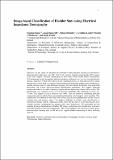| dc.contributor.author | Dunne, Eoghan | |
| dc.contributor.author | Santorelli, Adam | |
| dc.contributor.author | McGinley, Brian | |
| dc.contributor.author | Leader, Geraldine | |
| dc.contributor.author | O'Halloran, Martin | |
| dc.contributor.author | Porter, Emily | |
| dc.date.accessioned | 2021-03-22T15:02:58Z | |
| dc.date.available | 2021-03-22T15:02:58Z | |
| dc.date.issued | 2018-12-03 | |
| dc.identifier.citation | Dunne, Eoghan, Santorelli, Adam, McGinley, Brian, Leader, Geraldine, O’Halloran, Martin, & Porter, Emily. (2018). Image-based classification of bladder state using electrical impedance tomography. Physiological Measurement, 39(12), 124001. doi:10.1088/1361-6579/aae6ed | en_IE |
| dc.identifier.issn | 1361-6579 | |
| dc.identifier.uri | http://hdl.handle.net/10379/16616 | |
| dc.description.abstract | Objective: In this study, we examine the potential of using machine learning classification to determine the bladder state ( not full , full ) with electrical impedance tomography (EIT) images of the pelvic region. Accurate classification of these states would enable urinary incontinence (UI) monitoring to alert the patient, before involuntary voiding occurs, in a low-cost and discrete manner. Approach: Using both numerical and experimental data, we form datasets that contain diverse observations with varying clinical parameters such as bladder volume, urine conductivity, and the reference used for time-difference imaging. We then classify the bladder state using both pixel-wise and feature extraction-based classification techniques. We employ principal component analysis, wavelets, and image segmentation to help create features. Main results: The performance was compared across several classifier algorithms. The minimum accuracy was 77.50%. The highest accuracy observed was 100%, and was found by combining principal component analysis and the Gaussian radial based function kernel support vector machine. This combination also offered the best trade-off between classification performance and the costs of training time and memory space. The biggest challenge in bladder state classification is classifying volumes near the separation volume of not full and full, in which choosing the most suitable classifier combination can minimize this error. Significance: We performed the first machine learning classification of bladder EIT images, achieving high classification accuracies with both numerical and experimental data. This work highlights the potential of using image-based machine learning with an EIT device to support bladder monitoring for those suffering from UI. | en_IE |
| dc.description.sponsorship | This research was supported by funding from the European Research Council under the European Union’s
Horizon 2020 Programme/ ERC Grant Agreement BioElecPro n. 637780 and the charity RESPECT and
the People Programme (Marie Curie Actions) of the European Union’s Seventh Framework Programme
(FP7/2007-2013) under REA Grant Agreement no. PCOFUND-GA-2013-608728. The research was also
supported by the Irish Research Council under the fund GOIPD/2017/854. | en_IE |
| dc.format | application/pdf | en_IE |
| dc.language.iso | en | en_IE |
| dc.publisher | IOP Publishing | en_IE |
| dc.relation.ispartof | Physiological Measurement | en |
| dc.rights | Attribution-NonCommercial-NoDerivs 3.0 Ireland | |
| dc.rights.uri | https://creativecommons.org/licenses/by-nc-nd/3.0/ie/ | |
| dc.subject | electrical impedance tomography | en_IE |
| dc.subject | image classification | en_IE |
| dc.subject | urinary incontinence | en_IE |
| dc.subject | feature extraction | en_IE |
| dc.subject | machine learning | en_IE |
| dc.title | Image-based classification of bladder state using electrical impedance tomography | en_IE |
| dc.type | Article | en_IE |
| dc.date.updated | 2021-03-20T16:38:22Z | |
| dc.identifier.doi | 10.1088/1361-6579/aae6ed | |
| dc.local.publishedsource | https://doi.org/10.1088/1361-6579/aae6ed | en_IE |
| dc.description.peer-reviewed | peer-reviewed | |
| dc.contributor.funder | H2020 European Research Council | en_IE |
| dc.contributor.funder | RESPECT | en_IE |
| dc.contributor.funder | Seventh Framework Programme | en_IE |
| dc.contributor.funder | FP7 People: Marie-Curie Actions | en_IE |
| dc.contributor.funder | Irish Research Council | en_IE |
| dc.internal.rssid | 15506566 | |
| dc.local.contact | Eoghan Dunne, -. - Email: e.dunne13@nuigalway.ie | |
| dc.local.copyrightchecked | Yes | |
| dc.local.version | UPDATED | |
| dcterms.project | info:eu-repo/grantAgreement/EC/H2020::ERC::ERC-STG/637780/EU/Frontier Research on the Dielectric Properties of Biological Tissue/BIOELECPRO | en_IE |
| nui.item.downloads | 172 | |


